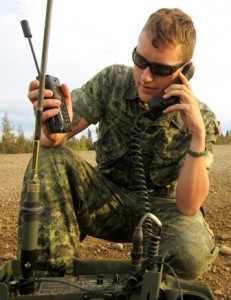Last spring, Rockwell Collins put a new spin on an old form of long haul communications, successfully streaming full colour video and ad hoc Internet Protocol networking over wideband high frequency (HF) radio.
The over-the-air test covered 2,414 kilometres between the company’s facilities in Ottawa and its corporate headquarters in Cedar Rapids, Iowa.
From proof of concept, Rockwell Collins is now building prototypes of wideband HF radios for technology demonstrations and will soon launch a product that could be a poster child for the export goals of the government’s new Defence Procurement Strategy (DPS).
“We’ve done demonstrations in Canada, the U.S., Australia, Brazil, South Africa,” said Lee Obst, managing director of Rockwell Collins Government Systems Canada. “We’ve either completed, or have commitments to complete within the next six months, about 25 technology demonstrations around the world.” During CANSEC in May the company hosted members of the U.S. Marine Corp, Army, Special Forces, Air Force and Department of Homeland Security for a demonstration.
Obst said a production model of the form factor is still a ways off as the company moves toward final certification, but “there is a lot of interest” for the product developed at its operations in Ottawa.
As demand for near-real time information continues to grow, the low rates of data transmission were seen as a barrier for HF communications systems. Rockwell Collins broke new ground by creating an HF waveform that allows it to increase the data rate 10 fold over conventional HF while still preserving the range. It might not be the high definition video streamed via satellites, but it is a close proximity in near-real time.
“Think of this as a wireless hub that has a 5,000-mile range,” Obst said. “We can send pictures 5,000 miles away without using SATCOM.”
He said the initial effort will focus on fixed ground sites and maritime opportunities – “we need to get the ground infrastructure done first” – but the company’s roadmap includes the development of airborne and ground vehicle radios.
Satellites might be the primary means of communications for modern militaries but HF radio is still an invaluable backup and an essential capability in SATCOM-denied environments. And WHF could prove vital for operations in the Arctic.
In a briefing in November 2013, for example, the Royal Canadian Air Force outlined its “persistent and increasing” requirement for strategic HF radio communications. While SATCOM is the RCAF’s system of choice for beyond-line-of-sight communications, not all aircraft are SATCOM-enabled. And in the High North, all aircraft have limited or no SATCOM access. As a result, HF is the backup to SAT phones and is often the “best and most effective means of comms” with ground stations and ground forces.
In particular, the RCAF pointed to its utility for Arctic and oceanic search and rescue and air-to-air refuelling operations. “CC-130 Hercs utilized by 435 Transport and Rescue Squadron are not SATCOM equipped [and] rely solely on HF comms as a lifeline while operating in Arctic and oceanic airspace,” the briefing slides stated. “[And] without HF the CC-130 Tanker would…experience greater difficulties operating in the far North.”
“HF communications remains an RCAF essential operational requirement,” the briefing concluded.
Obst believes WHF could serve as a reliable alternative, especially where infrastructure is difficult or expensive to establish. “We believe it fits well with the Canadian strategy for expanding capabilities in the North. As you…open up the Northwest Passage and shipping lanes and so forth, the demand would be there for communications. HF is an excellent means of providing that because you have long distances and few remote sites along the way,” he said in an interview last year.
Meeting Canadian needs might be the immediate priority, but with all the international interest, WHF is exactly the type of product the Defence Procurement Strategy was created to promote.
“We started before DPS but I think we can now leverage it,” Obst acknowledged at CANSEC. “Here is a Canadian technology, developed here, that is very exportable and in high demand. How do we leverage and promote that to meet DPS requirements and then provide further opportunities in Canada? Moving forward, I think DPS is going to help us streamline the processes and people will start to see more of [these types of products] come to fruition.”
